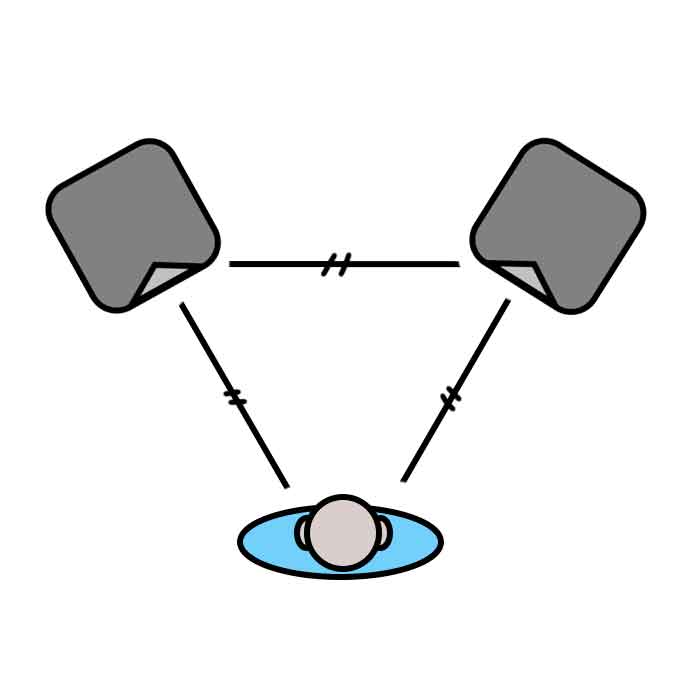Studio loudspeakers are a crucial element in music production. They allow for accurate sound reproduction and informed production decisions. However, their positioning is just as important as their technical features.
In this article, we’ll take a look at the different aspects of correctly positioning your studio speakers.
For ideal positioning, near-field monitors should be positioned at an equal angle to the listener, forming an equilateral triangle. Speakers should be placed at an appropriate listening height, usually at the listener’s ear level. It is also essential to position the speakers at an appropriate distance from the rear and side walls to minimize acoustic reflections. Acoustic treatments can also be used to improve the frequency response of the speakers by reducing reflections and acoustic interference.
What type of monitor can I use? What is Bass-Reflex? Can I use them in any room? That’s what we’ll look at in this article.
How do I position my studio monitors correctly?
The positioning of studio monitors is crucial to achieving accurate frequency response and stereo imaging. For ideal positioning, near-field monitors should be positioned at an equal angle to the listener, forming an equilateral triangle.
Speakers should be placed at an appropriate listening height, typically at the listener’s ear level. It is also important to position the speakers at an appropriate distance from the rear and side walls to minimize acoustic reflections from the walls.
What are the different types of studio monitors?
There are several types of studio monitors, each with its own characteristics and advantages.
Near-field monitors are most commonly used in small and personal studios, so they are likely to be used by amateur musicians, independent producers, podcasters and YouTubers. They are also used by professionals for precision listening during music production.
Medium field monitors are larger and are used in professional studios where space is at a premium. They are used by audio professionals to achieve accurate frequency response and stereo imaging.
Far field monitors are even larger and are used in large production studios.
Near field
Here is a table of the top three models of near-field studio monitors:
| Model | Power | Frequency response | Input type | Dimensions | Audience Ratings |
|---|---|---|---|---|---|
| Yamaha HS5 | 70 W | 54 Hz – 30 kHz | XLR, TRS | 170 x 285 x 222 mm | 4.6/5 |
| KRK Rokit 5 G4 | 55 W | 43 Hz – 40 kHz | XLR, TRS, RCA, Bluetooth | 190 x 252 x 231 mm | 4.5/5 |
| JBL Professional 305P MkII | 82 W | 49 Hz – 20 kHz | XLR, TRS, RCA | 251 x 185 x 222 mm | 4.7/5 |
These three models of near field studio monitors are very popular and have received high marks from the public.
The Yamaha HS5s are popular for their high accuracy, the KRK Rokit 5 G4s for their Bluetooth connectivity, and the JBL Professional 305P MkIIs for their balanced frequency response.
Near-field monitors are the most popular because they are designed for close-range listening, making them ideal for small spaces.
They are also used for precision listening in music production, as their frequency response is more accurate than other types of monitors.
However, they usually don’t have large enough baffles to reproduce very low frequencies. So be careful not to misunderstand the quality of reproduction, listening to songs you know, if you are looking to buy a pair of monitors.
Their prices are quite affordable, with an average of $400 – €400 for a pair of speakers.
Medium Field
Medium field monitors are larger and are used in professional studios, where space is at a premium and extended frequency response is required.
Here are three of the best models of medium-field studio monitors:
| Model | Power | Frequency Response | Input type | Dimensions | Audience ratings |
|---|---|---|---|---|---|
| Focal Solo6 Be | 150 W | 40 Hz – 40 kHz | XLR, RCA | 250 x 351 x 261 mm | 4.7/5 |
| Dynaudio LYD 48 | 80 W | 42 Hz – 21 kHz | XLR, RCA | 270 x 445 x 330 mm | 4.7/5 |
| Neumann KH 310 | 210 W | 34 Hz – 21 kHz | XLR, AES/EBU | 253 x 383 x 292 mm | 4.5/5 |
These three medium-field studio monitor models are popular with audio professionals.
- The Focal Solo6 Be is a popular choice for small to medium-sized studios.
- The Dynaudio LYD 48 is a newer model offering accurate frequency response and flexibility for audio connections.
- The Neumann KH 310 is a popular choice for large production studios.
All of these models offer accurate and detailed frequency response. High marks from the public are a testament to the quality of these studio monitors and their ability to provide clear, accurate sound for music production.
Although the price of a speaker is relatively high ($1000 – €1000), consider that this is equipment you will keep for years, even decades. An investment that should not be underestimated.
Far field
Far field monitors are even larger and are used in large production studios where accurate frequency response is essential for high quality music production.
Here is a table of the top three far-field studio monitor models:
| Model | Power | Frequency Response | Input Type | Dimensions | Audience Notes |
|---|---|---|---|---|---|
| Genelec 8351B | 330 W | D/A | XLR, AES/EBU, Dante | 452 x 287 x 278 mm | 4.6/5 |
| Focal Trio11 Be | 600 W | 30 Hz – 40 kHz | XLR, RCA | 383 x 630 x 371 mm | 4.9/5 |
| ATC SCM150ASL Pro | 350 W | 25 Hz – 20 kHz | XLR | 508 x 907 x 444 mm | 4.9/5 |
The Genelec 8351B is equipped with Dante connectivity for audio over IP networks, while the Focal Trio11 Be and the ATC SCM150ASL Pro offer higher power output.
These monitors are designed for professional production studios and sound engineers with high demands and high financial means. It is obvious that these models are not intended for the amateur public. The price (per speaker) is often above $4000 – €4000!
What is the impact of the size of the studio monitors on the sound?
The size of studio monitors is an important factor in achieving accurate frequency response. Larger monitors offer a wider frequency response (including very low frequencies), but require more space to be properly positioned.
Smaller monitors, on the other hand, are easier to position, but their frequency response can be limited, especially in the low frequencies. It is therefore crucial to choose the appropriate monitor size based on available space and production requirements.
Studio monitors that are too large for a small room can cause problems with interference and acoustic reflections, affecting accuracy and clarity of sound. It is critical to pick an appropriate monitor size based on available space and production requirements.
How does the room impact the sound?
Speaker placement should not be considered in isolation, as the room in which the speakers are placed has a significant impact on the soundstage. Walls, ceiling, floors, furniture and other elements in the room can all impact the frequency response of the speakers.
Acoustic treatments, such as absorber panels, can be used to reduce reflections and improve frequency response, especially on parallel walls. So it’s essential to consider these factors to get clear, accurate sound in your music production studio.
What is bass reflex?
Bass reflex is a common feature in studio monitors that improves frequency response in the low frequencies. However, it can also cause problems with interference and acoustic reflections.
Low frequencies tend to travel farther than high frequencies, which can cause acoustic interference and reflections in the room and can also cause objects in the room (acoustic guitar, chalkboard, cups, etc.) to resonate.
In general, bass-reflex should not be used as a substitute for proper placement of studio speakers, but rather as a means of improving the frequency response of the speakers.
Conclusion
Correct positioning of studio speakers and good sound isolation are essential to achieve accurate frequency response. The different types of studio monitors, their size, the room in which they are placed, bass reflex and sound isolation are important factors to consider when positioning them. With careful attention to these factors, you can achieve clear, accurate sound in your music production studio.


